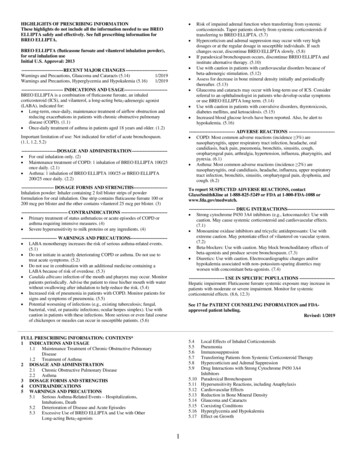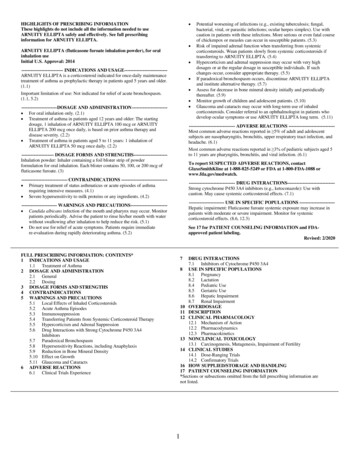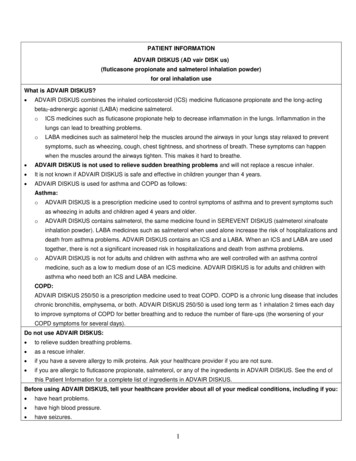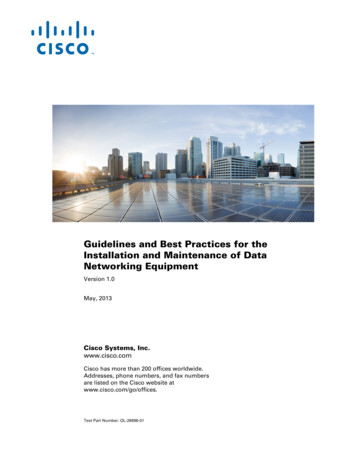
Transcription
HIGHLIGHTS OF PRESCRIBING INFORMATIONThese highlights do not include all the information needed to use BREOELLIPTA safely and effectively. See full prescribing information forBREO ELLIPTA. BREO ELLIPTA (fluticasone furoate and vilanterol inhalation powder),for oral inhalation useInitial U.S. Approval: 2013 --------------------------- RECENT MAJOR CHANGES --------------------------Warnings and Precautions, Glaucoma and Cataracts (5.14)1/2019Warnings and Precautions, Hyperglycemia and Hypokalemia (5.16)1/2019 --------------------------- INDICATIONS AND USAGE---------------------------BREO ELLIPTA is a combination of fluticasone furoate, an inhaledcorticosteroid (ICS), and vilanterol, a long-acting beta2-adrenergic agonist(LABA), indicated for: Long-term, once-daily, maintenance treatment of airflow obstruction andreducing exacerbations in patients with chronic obstructive pulmonarydisease (COPD). (1.1) Once-daily treatment of asthma in patients aged 18 years and older. (1.2) Risk of impaired adrenal function when transferring from systemiccorticosteroids. Taper patients slowly from systemic corticosteroids iftransferring to BREO ELLIPTA. (5.7)Hypercorticism and adrenal suppression may occur with very highdosages or at the regular dosage in susceptible individuals. If suchchanges occur, discontinue BREO ELLIPTA slowly. (5.8)If paradoxical bronchospasm occurs, discontinue BREO ELLIPTA andinstitute alternative therapy. (5.10)Use with caution in patients with cardiovascular disorders because ofbeta-adrenergic stimulation. (5.12)Assess for decrease in bone mineral density initially and periodicallythereafter. (5.13)Glaucoma and cataracts may occur with long-term use of ICS. Considerreferral to an ophthalmologist in patients who develop ocular symptomsor use BREO ELLIPTA long term. (5.14)Use with caution in patients with convulsive disorders, thyrotoxicosis,diabetes mellitus, and ketoacidosis. (5.15)Increased blood glucose levels have been reported. Also, be alert tohypokalemia. (5.16)------------------------------ ADVERSE REACTIONS ----------------------------- COPD: Most common adverse reactions (incidence 3%) arenasopharyngitis, upper respiratory tract infection, headache, oralcandidiasis, back pain, pneumonia, bronchitis, sinusitis, cough,oropharyngeal pain, arthralgia, hypertension, influenza, pharyngitis, andpyrexia. (6.1) Asthma: Most common adverse reactions (incidence 2%) arenasopharyngitis, oral candidiasis, headache, influenza, upper respiratorytract infection, bronchitis, sinusitis, oropharyngeal pain, dysphonia, andcough. (6.2)Important limitation of use: Not indicated for relief of acute bronchospasm.(1.1, 1.2, 5.2)----------------------- DOSAGE AND ADMINISTRATION ---------------------- For oral inhalation only. (2) Maintenance treatment of COPD: 1 inhalation of BREO ELLIPTA 100/25once daily. (2.1) Asthma: 1 inhalation of BREO ELLIPTA 100/25 or BREO ELLIPTA200/25 once daily. (2.2)--------------------- DOSAGE FORMS AND STRENGTHS---------------------Inhalation powder: Inhaler containing 2 foil blister strips of powderformulation for oral inhalation. One strip contains fluticasone furoate 100 or200 mcg per blister and the other contains vilanterol 25 mcg per blister. (3)To report SUSPECTED ADVERSE REACTIONS, contactGlaxoSmithKline at 1-888-825-5249 or FDA at 1-800-FDA-1088 --- DRUG INTERACTIONS------------------------------ Strong cytochrome P450 3A4 inhibitors (e.g., ketoconazole): Use withcaution. May cause systemic corticosteroid and cardiovascular effects.(7.1) Monoamine oxidase inhibitors and tricyclic antidepressants: Use withextreme caution. May potentiate effect of vilanterol on vascular system.(7.2) Beta-blockers: Use with caution. May block bronchodilatory effects ofbeta-agonists and produce severe bronchospasm. (7.3) Diuretics: Use with caution. Electrocardiographic changes and/orhypokalemia associated with non–potassium-sparing diuretics mayworsen with concomitant beta-agonists. (7.4)------------------------------ CONTRAINDICATIONS ----------------------------- Primary treatment of status asthmaticus or acute episodes of COPD orasthma requiring intensive measures. (4) Severe hypersensitivity to milk proteins or any ingredients. (4)----------------------- WARNINGS AND PRECAUTIONS----------------------- LABA monotherapy increases the risk of serious asthma-related events.(5.1) Do not initiate in acutely deteriorating COPD or asthma. Do not use totreat acute symptoms. (5.2) Do not use in combination with an additional medicine containing aLABA because of risk of overdose. (5.3) Candida albicans infection of the mouth and pharynx may occur. Monitorpatients periodically. Advise the patient to rinse his/her mouth with waterwithout swallowing after inhalation to help reduce the risk. (5.4) Increased risk of pneumonia in patients with COPD. Monitor patients forsigns and symptoms of pneumonia. (5.5) Potential worsening of infections (e.g., existing tuberculosis; fungal,bacterial, viral, or parasitic infections; ocular herpes simplex). Use withcaution in patients with these infections. More serious or even fatal courseof chickenpox or measles can occur in susceptible patients. (5.6)----------------------- USE IN SPECIFIC POPULATIONS ----------------------Hepatic impairment: Fluticasone furoate systemic exposure may increase inpatients with moderate or severe impairment. Monitor for systemiccorticosteroid effects. (8.6, 12.3)See 17 for PATIENT COUNSELING INFORMATION and FDAapproved patient labeling.Revised: 1/2019FULL PRESCRIBING INFORMATION: CONTENTS*1 INDICATIONS AND USAGE1.1 Maintenance Treatment of Chronic Obstructive PulmonaryDisease1.2 Treatment of Asthma2 DOSAGE AND ADMINISTRATION2.1 Chronic Obstructive Pulmonary Disease2.2 Asthma3 DOSAGE FORMS AND STRENGTHS4 CONTRAINDICATIONS5 WARNINGS AND PRECAUTIONS5.1 Serious Asthma-Related Events – Hospitalizations,Intubations, Death5.2 Deterioration of Disease and Acute Episodes5.3 Excessive Use of BREO ELLIPTA and Use with OtherLong-acting 145.155.165.171Local Effects of Inhaled ing Patients from Systemic Corticosteroid TherapyHypercorticism and Adrenal SuppressionDrug Interactions with Strong Cytochrome P450 3A4InhibitorsParadoxical BronchospasmHypersensitivity Reactions, including AnaphylaxisCardiovascular EffectsReduction in Bone Mineral DensityGlaucoma and CataractsCoexisting ConditionsHyperglycemia and HypokalemiaEffect on Growth
67810 OVERDOSAGE10.1 Fluticasone Furoate10.2 Vilanterol11 DESCRIPTION12 CLINICAL PHARMACOLOGY12.1 Mechanism of Action12.2 Pharmacodynamics12.3 Pharmacokinetics13 NONCLINICAL TOXICOLOGY13.1 Carcinogenesis, Mutagenesis, Impairment of Fertility14 CLINICAL STUDIES14.1 Chronic Obstructive Pulmonary Disease14.2 Asthma16 HOW SUPPLIED/STORAGE AND HANDLING17 PATIENT COUNSELING INFORMATION*Sections or subsections omitted from the full prescribing information are notlisted.ADVERSE REACTIONS6.1 Clinical Trials Experience in Chronic ObstructivePulmonary Disease6.2 Clinical Trials Experience in Asthma6.3 Postmarketing ExperienceDRUG INTERACTIONS7.1 Inhibitors of Cytochrome P450 3A47.2 Monoamine Oxidase Inhibitors and TricyclicAntidepressants7.3 Beta-adrenergic Receptor Blocking Agents7.4 Non–Potassium-Sparing DiureticsUSE IN SPECIFIC POPULATIONS8.1 Pregnancy8.2 Lactation8.4 Pediatric Use8.5 Geriatric Use8.6 Hepatic Impairment8.7 Renal ImpairmentFULL PRESCRIBING INFORMATION1INDICATIONS AND USAGE1.1Maintenance Treatment of Chronic Obstructive Pulmonary DiseaseBREO ELLIPTA 100/25 is indicated for the long-term, once-daily, maintenance treatment ofairflow obstruction in patients with chronic obstructive pulmonary disease (COPD), includingchronic bronchitis and/or emphysema. BREO ELLIPTA 100/25 is also indicated to reduceexacerbations of COPD in patients with a history of exacerbations. BREO ELLIPTA 100/25once daily is the only strength indicated for the treatment of COPD.Important Limitation of UseBREO ELLIPTA is NOT indicated for the relief of acute bronchospasm1.2Treatment of AsthmaBREO ELLIPTA is indicated for the once-daily treatment of asthma in patients aged 18 yearsand older. BREO ELLIPTA should be used for patients not adequately controlled on a long-termasthma control medication such as an inhaled corticosteroid (ICS) or whose disease warrantsinitiation of treatment with both an ICS and long-acting beta2-adrenergic agonist (LABA).Important Limitation of UseBREO ELLIPTA is NOT indicated for the relief of acute bronchospasm.2DOSAGE AND ADMINISTRATIONBREO ELLIPTA should be administered as 1 inhalation once daily by the orally inhaled routeonly.BREO ELLIPTA should be used at the same time every day. Do not use BREO ELLIPTA morethan 1 time every 24 hours.After inhalation, the patient should rinse his/her mouth with water without swallowing to helpreduce the risk of oropharyngeal candidiasis.2
More frequent administration or a greater number of inhalations (more than 1 inhalation daily) ofthe prescribed strength of BREO ELLIPTA is not recommended as some patients are more likelyto experience adverse effects with higher doses. Patients using BREO ELLIPTA should not useadditional LABA for any reason. [See Warnings and Precautions (5.3, 5.5, 5.8, 5.12).]2.1Chronic Obstructive Pulmonary DiseaseBREO ELLIPTA 100/25 should be administered as 1 inhalation once daily. The maximumrecommended dosage is 1 inhalation of BREO ELLIPTA 100/25 once daily, the only strengthindicated for the treatment of COPD.If shortness of breath occurs in the period between doses, an inhaled, short-acting beta2-agonist(rescue medicine, e.g., albuterol) should be taken for immediate relief.2.2AsthmaThe recommended starting dosage is BREO ELLIPTA 100/25 or BREO ELLIPTA 200/25administered as 1 inhalation once daily.When choosing the starting dosage strength of BREO ELLIPTA, consider the patients’ diseaseseverity, based on their previous asthma therapy, including the ICS dosage, as well as thepatients’ current control of asthma symptoms and risk of future exacerbation.The maximum recommended dosage is 1 inhalation of BREO ELLIPTA 200/25 once daily.The median time to onset, defined as a 100-mL increase from baseline in mean forced expiratoryvolume in 1 second (FEV1), was approximately 15 minutes after beginning treatment. Individualpatients will experience a variable time to onset and degree of symptom relief.For patients who do not respond adequately to BREO ELLIPTA 100/25, increasing the dose toBREO ELLIPTA 200/25 may provide additional improvement in asthma control.If asthma symptoms arise in the period between doses, an inhaled, short-acting beta2-agonist(rescue medicine, e.g., albuterol) should be taken for immediate relief.If a previously effective dosage regimen of BREO ELLIPTA fails to provide adequateimprovement in asthma control, the therapeutic regimen should be reevaluated and additionaltherapeutic options (e.g., replacing the current strength of BREO ELLIPTA with a higherstrength, adding additional ICS, initiating oral corticosteroids) should be considered.3DOSAGE FORMS AND STRENGTHSInhalation powder: Disposable light grey and pale blue plastic inhaler containing 2 foil blisterstrips of powder intended for oral inhalation only. One strip contains fluticasone furoate (100 or200 mcg per blister), and the other strip contains vilanterol (25 mcg per blister).4CONTRAINDICATIONSThe use of BREO ELLIPTA is contraindicated in the following conditions:3
Primary treatment of status asthmaticus or other acute episodes of COPD or asthma whereintensive measures are required [see Warnings and Precautions (5.2)]. Severe hypersensitivity to milk proteins or demonstrated hypersensitivity to fluticasonefuroate, vilanterol, or any of the excipients [see Warnings and Precautions (5.11),Description (11)].5WARNINGS AND PRECAUTIONS5.1Serious Asthma-Related Events – Hospitalizations, Intubations, DeathUse of LABA as monotherapy (without ICS) for asthma is associated with an increased risk ofasthma-related death [see Salmeterol Multicenter Asthma Research Trial (SMART)]. Availabledata from controlled clinical trials also suggest that use of LABA as monotherapy increases therisk of asthma-related hospitalization in pediatric and adolescent patients. These findings areconsidered a class effect of LABA monotherapy. When LABA are used in fixed-dosecombination with ICS, data from large clinical trials do not show a significant increase in the riskof serious asthma-related events (hospitalizations, intubations, death) compared with ICS alone(see Serious Asthma-Related Events with Inhaled Corticosteroid/Long-acting Beta2-adrenergicAgonists).Serious Asthma-Related Events with Inhaled Corticosteroid/Long-acting Beta2-adrenergicAgonistsFour (4) large, 26-week, randomized, double-blind, active-controlled clinical safety trials wereconducted to evaluate the risk of serious asthma-related events when LABA were used infixed-dose combination with ICS compared with ICS alone in subjects with asthma. Three (3)trials included adult and adolescent subjects aged 12 years and older: 1 trial comparedbudesonide/formoterol with budesonide, 1 trial compared fluticasone propionate/salmeterolinhalation powder with fluticasone propionate inhalation powder, and 1 trial comparedmometasone furoate/formoterol with mometasone furoate. The fourth trial included pediatricsubjects aged 4 to 11 years and compared fluticasone propionate/salmeterol inhalation powderwith fluticasone propionate inhalation powder. The primary safety endpoint for all 4 trials wasserious asthma-related events (hospitalizations, intubations, death). A blinded adjudicationcommittee determined whether events were asthma related.The 3 adult and adolescent trials were designed to rule out a risk margin of 2.0, and the pediatrictrial was designed to rule out a risk margin of 2.7. Each individual trial met its pre-specifiedobjective and demonstrated non-inferiority of ICS/LABA to ICS alone. A meta-analysis of the 3adult and adolescent trials did not show a significant increase in risk of a serious asthma-relatedevent with ICS/LABA fixed-dose combination compared with ICS alone (Table 1). These trialswere not designed to rule out all risk for serious asthma-related events with ICS/LABAcompared with ICS.4
Table 1. Meta-analysis of Serious Asthma-Related Events in Subjects with Asthma Aged12 Years and OlderICS/LABA vs. ICSICS/LABAICSHazard Ratioaa(n 17,537)(n 17,552)(95% CI)bSerious asthma-related eventc1161051.10 (0.85, 1.44)Asthma-related death20Asthma-related intubation(endotracheal)12Asthma-related hospitalization( 24-hour stay)115105ICS Inhaled Corticosteroid, LABA Long-acting Beta2-adrenergic Agonist.aRandomized subjects who had taken at least 1 dose of study drug. Planned treatment used foranalysis.bEstimated using a Cox proportional hazards model for time to first event with baselinehazards stratified by each of the 3 trials.cNumber of subjects with event that occurred within 6 months after the first use of study drugor 7 days after the last date of study drug, whichever date was later. Subjects can have one ormore events, but only the first event was counted for analysis. A single, blinded, independentadjudication committee determined whether events were asthma related.The pediatric safety trial included 6,208 pediatric subjects aged 4 to 11 years who receivedICS/LABA (fluticasone propionate/salmeterol inhalation powder) or ICS (fluticasone propionateinhalation powder). In this trial, 27/3,107 (0.9%) subjects randomized to ICS/LABA and21/3,101 (0.7%) subjects randomized to ICS experienced a serious asthma-related event. Therewere no asthma-related deaths or intubations. ICS/LABA did not show a significantly increasedrisk of a serious asthma-related event compared with ICS based on the pre-specified risk margin(2.7), with an estimated hazard ratio of time to first event of 1.29 (95% CI: 0.73, 2.27).Salmeterol Multicenter Asthma Research Trial (SMART)A 28-week, placebo-controlled, U.S. trial that compared the safety of salmeterol with placebo,each added to usual asthma therapy, showed an increase in asthma-related deaths in subjectsreceiving salmeterol (13/13,176 in subjects treated with salmeterol versus 3/13,179 in subjectstreated with placebo; relative risk: 4.37 [95% CI: 1.25, 15.34]). Use of background ICS was notrequired in SMART. The increased risk of asthma-related death is considered a class effect ofLABA monotherapy.5.2Deterioration of Disease and Acute EpisodesBREO ELLIPTA should not be initiated in patients during rapidly deteriorating or potentiallylife-threatening episodes of COPD or asthma. BREO ELLIPTA has not been studied in subjects5
with acutely deteriorating COPD or asthma. The initiation of BREO ELLIPTA in this setting isnot appropriate.COPD may deteriorate acutely over a period of hours or chronically over several days or longer.If BREO ELLIPTA 100/25 no longer controls symptoms of bronchoconstriction; the patient’sinhaled, short-acting, beta2-agonist becomes less effective; or the patient needs more short-actingbeta2-agonist than usual, these may be markers of deterioration of disease. In this setting areevaluation of the patient and the COPD treatment regimen should be undertaken at once. ForCOPD, increasing the daily dose of BREO ELLIPTA 100/25 is not appropriate in this situation.Increasing use of inhaled, short-acting beta2-agonists is a marker of deteriorating asthma. In thissituation, the patient requires immediate reevaluation with reassessment of the treatmentregimen, giving special consideration to the possible need for replacing the current strength ofBREO ELLIPTA with a higher strength, adding additional ICS, or initiating systemiccorticosteroids. Patients should not use more than 1 inhalation once daily of BREO ELLIPTA.BREO ELLIPTA should not be used for the relief of acute symptoms, i.e., as rescue therapy forthe treatment of acute episodes of bronchospasm. BREO ELLIPTA has not been studied in therelief of acute symptoms and extra doses should not be used for that purpose. Acute symptomsshould be treated with an inhaled, short-acting beta2-agonist.When beginning treatment with BREO ELLIPTA, patients who have been taking oral or inhaled,short-acting beta2-agonists on a regular basis (e.g., 4 times a day) should be instructed todiscontinue the regular use of these drugs and to use them only for symptomatic relief of acuterespiratory symptoms. When prescribing BREO ELLIPTA, the healthcare provider should alsoprescribe an inhaled, short-acting beta2-agonist and instruct the patient on how it should be used.5.3Excessive Use of BREO ELLIPTA and Use with Other Long-acting Beta2-agonistsBREO ELLIPTA should not be used more often than recommended, at higher doses thanrecommended, or in conjunction with other medicines containing LABA, as an overdose mayresult. Clinically significant cardiovascular effects and fatalities have been reported inassociation with excessive use of inhaled sympathomimetic drugs. Patients using BREOELLIPTA should not use another medicine containing a LABA (e.g., salmeterol, formoterolfumarate, arformoterol tartrate, indacaterol) for any reason.5.4Local Effects of Inhaled CorticosteroidsIn clinical trials, the development of localized infections of the mouth and pharynx with Candidaalbicans has occurred in subjects treated with BREO ELLIPTA. When such an infectiondevelops, it should be treated with appropriate local or systemic (i.e., oral) antifungal therapywhile treatment with BREO ELLIPTA continues, but at times therapy with BREO ELLIPTAmay need to be interrupted. Advise the patient to rinse his/her mouth with water withoutswallowing following inhalation to help reduce the risk of oropharyngeal candidiasis.6
5.5PneumoniaAn increase in the incidence of pneumonia has been observed in subjects with
2 DOSAGE AND ADMINISTRATION 2.1 Chronic Obstructive Pulmonary Disease 2.2 Asthma 3 DOSAGE FORMS AND STRENGTHS 4 CONTRAINDICATIONS 5 WARNINGS AND PRECAUTIONS 5.1 Serious Asthma-Related Events – Hospitalizations, Intubations, Death 5.2 Deterioration of Disease and Acute Epis











